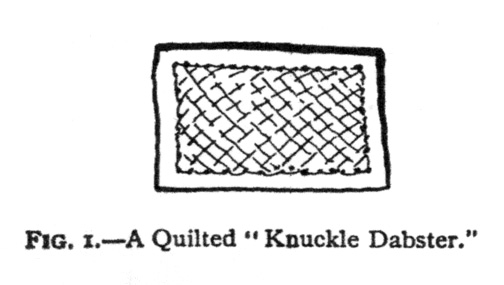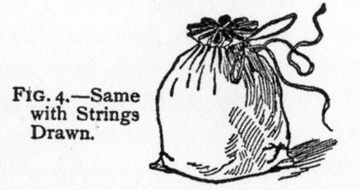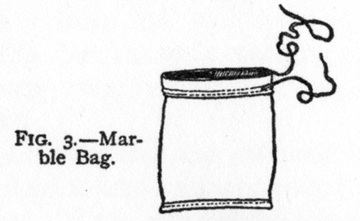|
The Right Spirit
It is not necessary to gamble with
marbles, as many suppose, and in fact there is little doubt
that the game was first played " for keeps " centuries ago
when pebbles were used for marbles and the pebbles won were
only valued as trophies or counters. In reality a marble won
is a point won in the game, and it is not necessary to keep
the marbles after the game is over, any more than it is
necessary to keep the balls and bats of the defeated
base-ball players or the balls and rackets of the defeated
lawn-tennis players or the foot-ball of the defeated
foot-ball players. What the American boy plays for is to win
the game, not the implements of the sport. It is only the
occasional "tough" who manages to get into the game who has
the real instincts of the gambler, and he is the boy who
always cries "grinder," and "snatches up " or " swipes " the
marbles of smaller or more timid lads. Such a boy should be
avoided just as respectable men avoid the gambler and
black-leg.
Knuckle
Dabsters
Every boy who plays marbles should possess a knuckle
dabster; these can be made from bits of soft woolen cloth,
felt, or the skin of small animals. Mole
skins make the softest and prettiest of knuckle dabsters,
but any piece of fur will answer. Some boys wear them
fastened to the hand, but the most expert players seem to
prefer to throw them down at the spot from which they are
about to shoot and then knuckle down on the soft fur or
woolen cloth. A knuckle dabster prevents one's
knuckles from becoming sore and raw, and adds greatly to the
comfort of the player.
 
A Marble Bag
Your sister, mother, aunt, or
grandmother can in a few moments stitch two pieces of thick,
soft cloth together for you when marble time arrives, and if
they will add to this favor by making you
a marble bag [Fig 3,4] with strings to draw the mouth
together, you are ready for the season. The marble bag
should be small enough to slip into your pocket, where it
will prevent the loss of many marbles that might work their
way through that hole that is always to be found in a boy's
pocket after he has worn his clothes for a short time.
I remember
how I used to plan leather and buckskin pockets that would
not wear out, and I made up my mind that when I was old
enough to make money and buy my own clothes the tailor
should be instructed to put in leather pockets. Alas! when
I reached that age it took so much cash to buy the clothes
that there was never enough in the pockets to wear them out.
 
Whom to Play Marbles
With
If Little Lord Fauntleroy had been born in a Western town
his life would not have been worth living. He was a gentle
little " sissy "aristocrat, who would never have been
tolerated by the " Huck " Finns and Tom Sawyers inhabiting
the valleys of the Mississippi and its tributaries.
Imagine, if
you can, such a little chap wearing the clothes with which
Mr. Birch, in his beautiful illustrations, so appropriately
dressed him; imagine him down on one knee, with his girlish
hand chapped with the wind and the cracks filled with grime,
knuckling down and lofting on the ducks in the middle of a
bull ring, or with doubled fists standing over his marbles,
defending his property against some young highwayman from
the rolling mill on the river bank!
As the New
York boys would say, " He wouldn't be in it." No, the house
is the place for him. This is a rough world, and it requires
experiences outside of a gentle, loving mother's care or the
sweet lady-like tuition of a governess to fit a lad for the
battle of life.
What we
want for a playmate is a fair and square fellow, who will
stand by a friend through thick and thin, and, without being
quarrelsome, defend his rights and never " weaken." It is
unnecessary to say that such a lad's love of justice will
always prevent him from imposing upon smaller boys and his
manliness will cause him to treat his companion and the
girls with courtesy. You need not watch him in any game, for
he will not cheat. Among my old schoolmates I have known
many such fellows, and, to a man, they are all good fellows
now; good citizens, good fathers, and they still enjoy
watching the boys play the games in which they used to excel
themselves.
How Marbles Were First
Made
With the aid of frost and sun nature splits the rocks,
dropping the fragments into the water, and the ever moving
water rolls the fragments over each other and against ot her
stones until they become smooth pebbles, many of which are
almost as round as the marbles sold in stores. Away back
before history was written the children used these natural
marbles to play with, but there is nothing to tell us
whether they used a `1 long ring " or a " bull ring," or
what rules governed the game.
When the
Tammany Halls of Rome and the citizens in general became
wicked and corrupt it made nature very ill, and she broke
out in volcanoes. While the terrible fires from the bowels
of the earth were spouting and scattering their ashes and
lava over towns and cities, Pompeii was buried with all its
streets and houses and with some of its people and dogs.
Among the many curious things found in the ruins by the
antiquarians who have unearthed the old cities were-what?
Marbles left by the boys in their flight from the doomed
city, and, I think, if the truth were known, some of the
little rascals delayed their departure long enough to secure
and carry away with them their " megs," as the New York boys
would call the ancient marbles.
Marbles in America
One hundred
and twenty-eight years after Columbus discovered America,
and when many of the ancestors of this generation of boys
could call themselves Americans, the Dutchmen imported
marbles to England, and it is very probable the old
Knickerbockers introduced them here, but it matters little
who had the honor of introducing them to America. They came
to stay, and now, from California to Maine, and from the
Calumet and Hecla mines at Red Jacket, Mich., to New
Orleans, the boys all play marbles.
Made Abroad Nowadays
Where do
they all come from? Some of you win them, some of you trade
postage-stamps for them, but some person bought them,
probably, at the little store around the corner.
When I
attended the Eighth Street District School in Cincinnati we
used to replenish our stock from "Malaney's." I do not
recollect the real name of the proprietor of the little
store, but that is the name it went by among the boys. There
we bought our butterscotch and bull's-eye candy; our
match-sticks for kites, our elastic bands for slings, our
tops and top-strings.
Local Names of Marbles
But Malaney
must have secured his supply from some. where, because I
know he did not make them himself, and he always had a
quantity on hand of "potteries," "plasters," " chinas," "
crystals," " agates," " alleys," and " commies."
Atlantic
coast boys do not use these names, but they use the same
marbles. We had a tradition that the potteries were made at
a pottery near the Brighton Hotel in the suburbs of
Cincinnati. What truth, if any, there is in this tradition I
am unable to state. In New York I seldom see this rich brown
mottled marble, whose glossy surface is marked by three
rough dots.
The
"crockery" never had the splashes of white that
distinguished the "burned agate" of New York, nor the green
of the "moss agate" of the same place. Both of the latter
were unknown to the Western boys twenty-five years ago.
At the
beginning of this century marbles were some times called
"bowls," and all came from Nuremberg, down the Rhine to
Rotterdam, and thence to all other parts of Europe.
|
